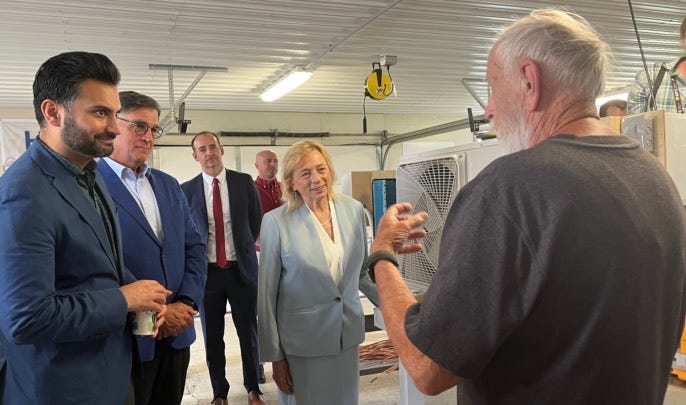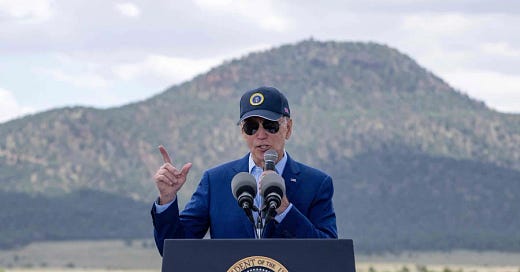The Weekly Anthropocene, September 27 2023
The American Climate Corps is born, heat pumps and airport solar keep growing, salmon to be restored to the Upper Columbia River, Brazil continues its environmental renaissance, and more!
United States: Wildlife
The critically endangered desert tortoise (Gopherus agassizii) is used to the scorching heat of the Mojave Desert, but scientists are concerned that climate change may drive temperatures too high for even their hard-won adaptations. Now, a research team has attached iButtons, a commonly used sensor, to 115 desert tortoises in order to better understand how hot they’re getting, and perhaps model where global warming might cause problems for them in the future. The researchers are also using iButtons to measure temperatures in the tortoises’ extensive underground burrows, and have already found that the depths can be over 30°F cooler than the entrance. Another awesome use of technology to facilitate innovative conservation!
In other chelonian news, a study of red-eared slider turtles found that warming temperatures may cause them to produce more eggs. As it was already well-known that warmer temperatures may cause turtles to produce disproportionately female offspring, this opens up interesting possibilities for the future of wild turtles’ reproduction in a warming world.
The Biden Administration has agreed to provide $208 million in funding to support a coalition of five Native American tribes’ efforts to reintroduce salmon to the upper Columbia River basin in Washington State and Idaho. The tribes will build hatcheries, release salmon, and plan to actively help them migrate on the dam-studded river by trucking them around major hydroelectric projects like the Grand Coulee Dam. Great news!
The spotted lanternfly, a sap-feeding “invasive” insect species that arrived from China in 2012, was long feared as a potential threat to America’s hardwood trees, with extensive yet unsuccessful eradication campaigns enacted. Now, new research has found that they do not appear to be a serious threat to hardwood trees, with experiments testing a “worst-case scenario” in which spotted lanternflies fed on the same trees for four consecutive growing seasons resulting in zero trees dying. Yet another example of invasive species turning out to be harmless!
United States: Climate Action
On September 20, President Biden announced the creation of the American Climate Corps. Modeled on classic American service initiatives like FDR’s Civilian Conservation Corps, JFK’s Peace Corps, and Bill Clinton’s AmeriCorps, the American Climate Corps is set to create 20,000 paying jobs in its first year for young people to work on “clean energy, conservation and climate resilience” projects. Example jobs include coastal wetland restoration for flood protection, clean energy deployment, and wildlife-preventing forestr management. Ten states across the country (California, Colorado, Maine, Michigan, Washington, Arizona, Utah, Minnesota, North Carolina, and Maryland) are partnering their state-level climate corps with the new federal initiative. You can learn about joining the American Climate Corps online.

Heat pumps are rapidly spreading across America. The clean all-electric heating and cooling systems overtook gas furnaces sales for the first time in 2022, with over 4 million heat pumps sold. And they’re looking like more and more of a good deal: a recent study in Joule found that modern electric heat pumps substantially outperform fossil fuel-burning boilers and furnaces, even in cold temperatures. Now, the 25-governor U.S. Climate Alliance, representing 55% of the U.S. population, has announced a new plan to install 20 million heat pumps by 2030. White House National Climate Advisor Ali Zaidi noted that the new American Climate Corps may prove helpful in training more electricians to install all those heat pumps.
Notably, this writer’s home state of Maine has been at the center of heat pumps’ adoption in America; Maine Governor Janet Mills is a co-chair of the U.S. Climate Alliance, and had announced in 2019 a goal of installing 100,000 heat pumps by 2025. In fact, Maine installed 104,000 by July 2023, and recently set a new target of installing another 175,000 by 2027. Heat pumps, like EVs and solar panels, are an emerging example of cleaner technologies winning because they’re just better than their fossil fueled alternatives. The more government support we get to speed up that transition, the faster we reduce air pollution and greenhouse gas emissions. Great news!
Airports across America are building vast solar farms. Dulles International Airport outside Washington D.C. is currently building an 835-acre array with 100 megawatts of solar generation capacity (from a planned 200,000 panels) plus 50 megawatts of battery storage. And Kansas City International Airport is on the verge of approving a multi-year solar buildout that could reach 500 megawatts of generating capacity. Great news!
This newsletter has long called for environmentalists to support new transmission line projects, vital for the clean energy buildout. Recently, The Wilderness Society wrote about a successful example of such collaboration. For the 125-mile Ten West Link power line between Arizona and California, which broke ground in spring 2023, environmental NGOs worked with federal agencies and local people to identify a transmission line route with minimal environmental impact, following Interstate 10 and avoiding a wildlife refuge. Great work—let’s keep it up!
Brazil
As deforestation in the Brazilian Amazon continues to drop, President Lula da Silva is continuing to lead a Brazilian environmental and climate action renaissance.
Lula recently restored Brazil’s 2015 greenhouse gas emissions reduction targets (which were weakened by Bolsonaro), returning Brazil to its previous level of climate action commitment.
A bill to create a cap-and-trade system for industrial emissions is working its way through Brazil’s Congress.
Spurred on by commercial pressure from the European Union’s anti-deforestation laws, Brazil’s banking system is instituting new credit rules that will require meatpackers and slaughterhouses to prove that their cattle didn’t come from illegally forested lands. This could be huge!
One of the most shameful episodes of Brazil’s dark years under President Jair Bolsonaro was his encouragement of the arguably-genocidal attacks by thousands of illegal gold miners against the Yanomami indigenous people, which resulted in horrifying mass starvation by 2022 as the illegal mines’ mercury poisoned vital fish-bearing rivers. Newly elected Brazilian President Lula da Silva, replacing Bolsonaro in January 20231, sent in federal special forces and several police agencies to expel the illegal miners in February 2023, complemented by an immense healthcare effort.
Now, though conflict is ongoing, substantial progress has been made in protecting the Yanomami. In June 2023, satellite data found zero illegal mining alerts in Yanomami territory for the first time since 2020. By July 2023, Brazilian Minister of Indigenous Peoples2 Sonia Guajajara reported that 82% of the miners had been removed from Yanomami land, while efforts to heal malnourished Yanomami children are already starting to work.
The Brazilian Supreme Court recently ruled against a Bolsonaro-era legal theory that would have stripped legal protections from vast swathes of indigenous lands, opening them up to logging and mining. This is a huge bullet dodged!
A new study in Science Advances adds weight to the theory that the Amazon’s super-fertile “terra preta” soils (which cover only a few percentage points of the forest but are disproportionately rich in nutrients) were intentionally created by ancient indigenous civilizations. The researchers analyzed soil enriched by modern indigenous peoples’ practices of the soil with fishing waste, ash, and agricultural waste, finding substantial similarities with the ancient soils. They also found that in some ancient sites, the terra preta soils store as much carbon than the aboveground forest biomass! The ancient peoples of Amazonia have left a gift that is already helping us in the fight to stabilize Earth’s climate—and may be even more valuable as an example to follow.
Despite a pro-Bolsonaro attempted coup on January 8, 2023, inspired by the American attempted coup on January 6, 2021. Both were successfully defeated, failing to overthrow the duly elected Presidents Joe Biden and Lula da Silva.








Another great issue. Lanternfly news is very welcome. I ❤️ the American Climate Corps!! The minimum impact line to California is great. Things are looking up in many ways.